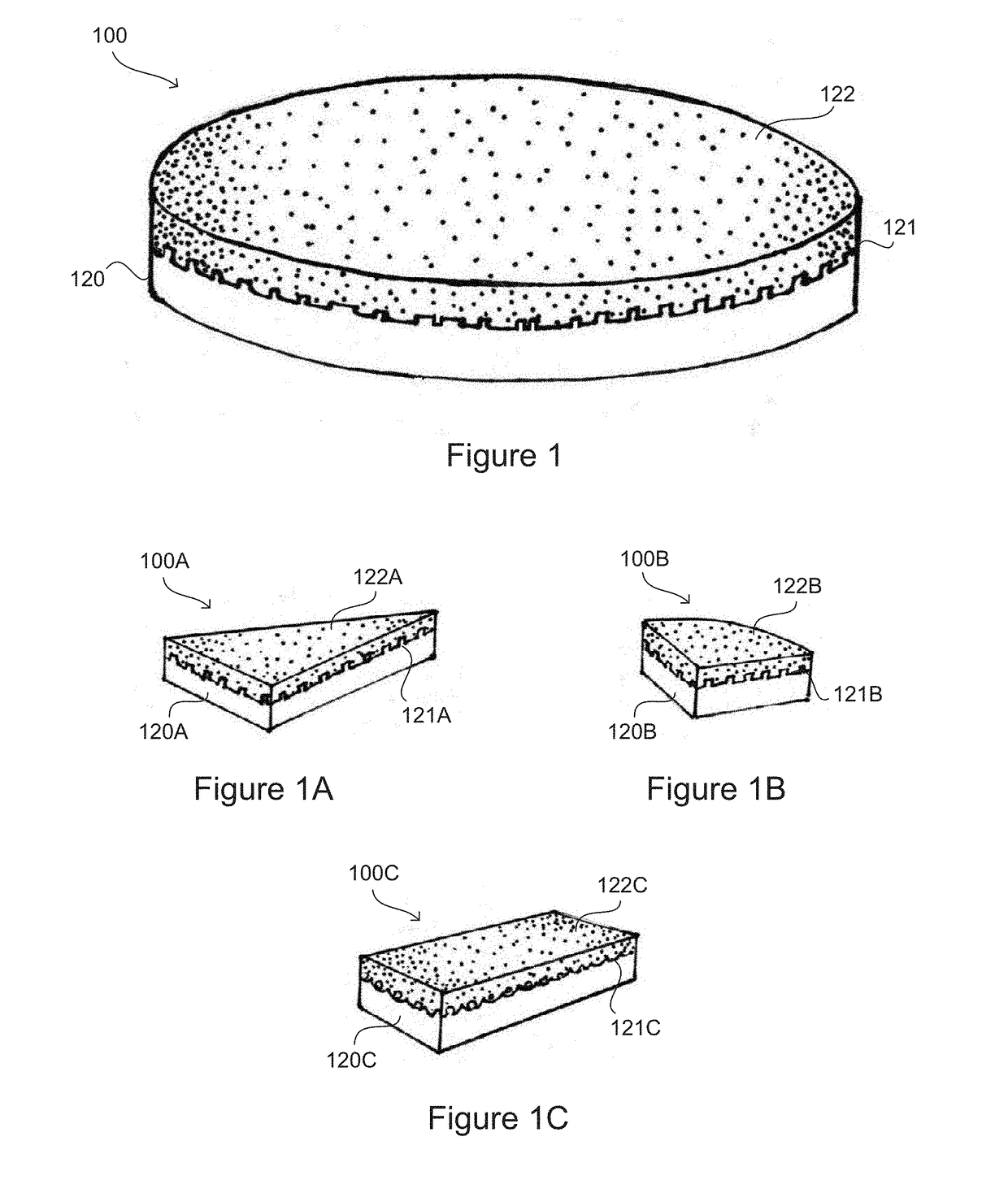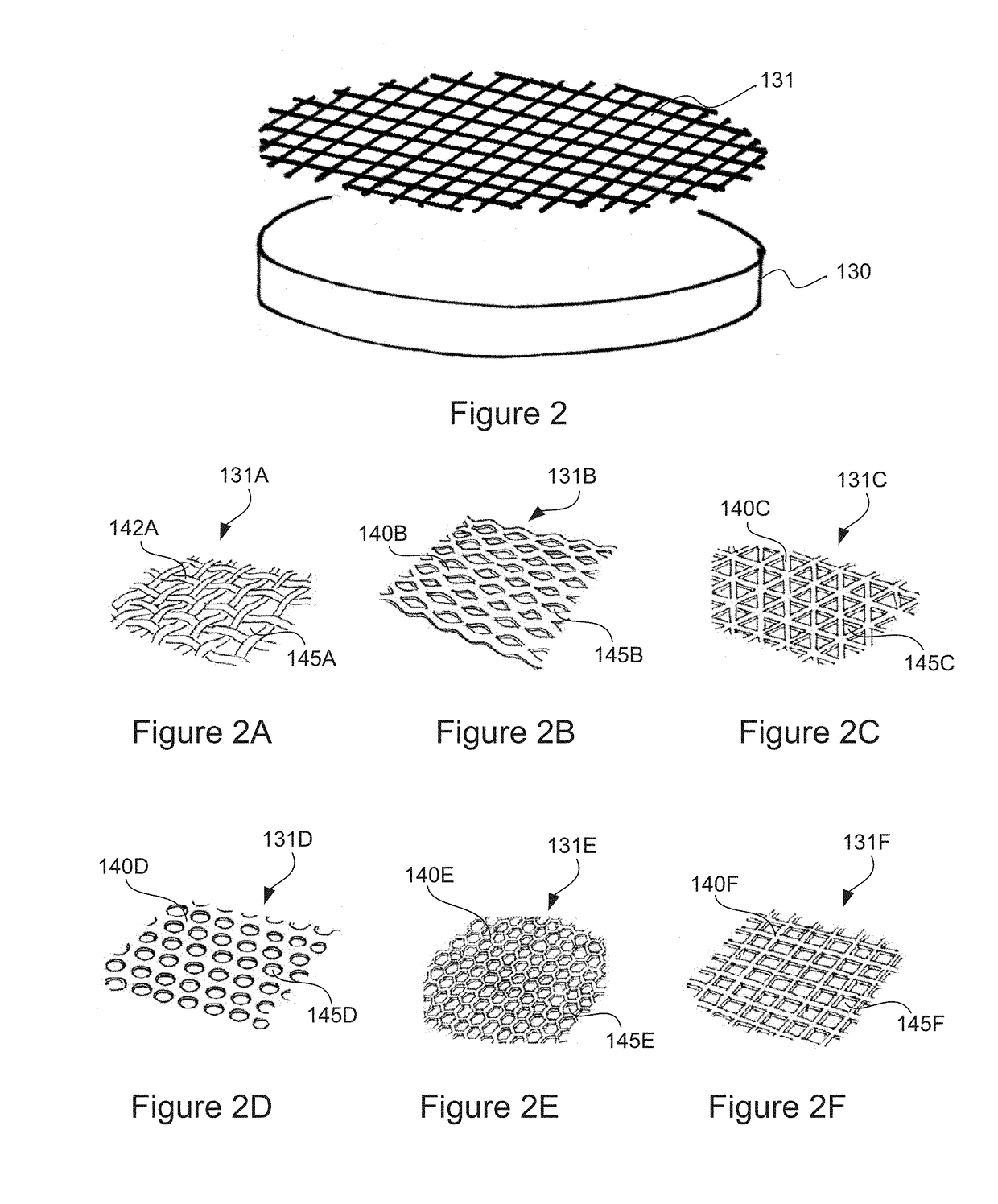Superabrasive tool with metal mesh stress stabilizer between superabrasive and substrate layers
a technology of stress stabilizer and superabrasive, which is applied in the field of blanks, can solve the problems of functionality and available equipment limitation, and achieve the effects of less curvature, less bowed, and improved product yield
- Summary
- Abstract
- Description
- Claims
- Application Information
AI Technical Summary
Benefits of technology
Problems solved by technology
Method used
Image
Examples
example 1
[0067]A cleaned tantalum cup is prepared and 8 grams of cleaned (fired at 1050° C. for 2 hours in a hydrogen gas atmosphere) fine diamond powders of 8-12 microns size are loaded into the bottom of the cup. The diamond powder is then packed well by tamping, shaking, and pushing with a stainless steel spoon. Next an assembly of metal mesh / cobalt cemented tungsten carbide round disc (13-16 wt. % cobalt content) is made by spot welding a piece of metal mesh (having the same diameter as the tungsten carbide disc and 0.12 mm thick) on the surface of tungsten carbide disc. The metal mesh is a molybdenum wire woven mesh of 0.12 mm diameter and having a pore size of 0.40×0.40 mm. The mesh may be pure molybdenum or may contain a trace of other transient metals. The assembled metal mesh / tungsten carbide disc is placed on top of the packed diamond powder of the tantalum cup with the metal mesh being interfaced with the diamond powder. The reaction cup-assembly is completed by closing of the tan...
example 2
[0070]The same procedure as in Example 1 is followed for making PCBN blank with a wire woven molybdenum mesh interface placed at the PCBN / tungsten carbide interface as in Example 1. The same tantalum reaction cup assembly is prepared including a sheet of wire woven molybdenum mesh welded on the surface of tungsten carbide substrate disc. A CBN powder feedstock including its binder materials is loaded in the Ta-cup followed by powder packing as in Example 1. The tungsten carbide substrate with wire mesh combination is then loaded on top of the packed CBN powder layer and a complete reaction-cup assembly is finished by clamping the Ta cup.
[0071]This PCBN reaction-cup assembly is then loaded into the final HPHT cell assembly and subjected to similar pressure and temperature as in Example 1 in the HPHT press for about 20 minutes pressing cycle time. The resulting as-pressed PCBN blank is taken out of the pressed cell and followed by a normal finishing operation as applied in Example 1. ...
example 3
[0074]The similar cup assembly is prepared as in Examples 1 and 2 but using a thicker tungsten carbide substrate disc as well as using a thicker or taller PCD layer material prepared. The tungsten carbide substrate disc having a thickness of 8 mm and a diameter of 54 mm and a taller molybdenum mesh having a height or thickness of 1.25 mm height are assembled as in Example 1. First, an assembly of tungsten carbide disc attached with molybdenum mesh is fitted into the bottom of a Ta cup. Following this there is loaded 230 / 270 mesh diamond powder up to the ¾ of the height of the metal mesh followed by loading a trimodal fine diamond feed consisting of 25-35 microns as a main size with 8-12 microns and 4-6 microns diamond powder as minor sizes to a cup height of up to 5-6 mm more on top of the coarser diamond layer.
[0075]The cup is closed and placed in an HPHT press and subjected to a temperature of 1400° C. at a pressure of 55 kilobars for 30 minutes.
[0076]The resulting as-pressed PCD ...
PUM
| Property | Measurement | Unit |
|---|---|---|
| width | aaaaa | aaaaa |
| thickness | aaaaa | aaaaa |
| length | aaaaa | aaaaa |
Abstract
Description
Claims
Application Information
 Login to View More
Login to View More - R&D
- Intellectual Property
- Life Sciences
- Materials
- Tech Scout
- Unparalleled Data Quality
- Higher Quality Content
- 60% Fewer Hallucinations
Browse by: Latest US Patents, China's latest patents, Technical Efficacy Thesaurus, Application Domain, Technology Topic, Popular Technical Reports.
© 2025 PatSnap. All rights reserved.Legal|Privacy policy|Modern Slavery Act Transparency Statement|Sitemap|About US| Contact US: help@patsnap.com



